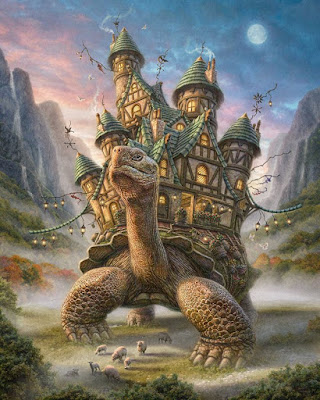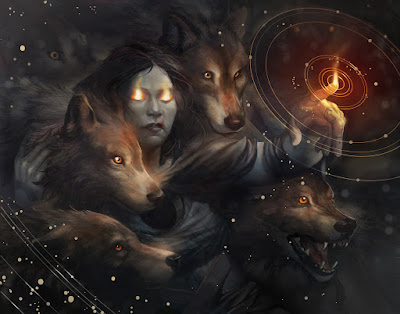 |
| According to the DMG, you should have died 3 days ago |
I put a lot of work into game prep. This includes normal prep activities, such as writing out scene descriptions, planning major plot points, and creating monsters to fight, but it also includes making compelling systems for the players to experience the world with.
This will probably merit another article down the line, but I am a big fan of boardgames. To me, it is the simplest way to see how a particular set of rules translates into a player experience. When you can relate that experience to a different kind of real-world situation, you have the potential to use an existing ruleset to create choice and tension within the game.
I won't dig into this, but suffice to say that part of a DM's job is to engage their players, and I prefer to set up a world as much as possible to help my players engage with it.
But what about when players have the freedom to run amok?
Structured Improvisation
 |
| I don't care if the king's name is Lichy McLichface, I want to go there! |
Any improv show, from Whose Line is it Anyway to Chicago's Second City, basically uses the stage to tell a story without planning it out. Even the incredibly short jokes from Whose Line, such as during the "Props" or "Scenes From a Hat" games, use the tropes of storytelling and audience expectation to create humor.
Fewer people are familiar with the idea of long-form improv, where instead of playing set games and focusing on jokes, a group of actors gathers details to essentially create a play on the spot.
Most people would find this very difficult to do in front of an audience, and I'd wager that even experienced low-prep DM's would struggle at first. There are no rulebooks, no setting documents, no monsters or stats or ability scores. There's no dungeon master or referee stating what is and isn't possible.
But there are rules.
The most obvious source of rules is the structure of a story itself. Whether you think in terms of the three-act-structure, the hero's journey, Dan Harmon's Story Circle, or the story arc, the basics are present and similar across many stories. Following these tropes can lead to a good story structure, and it is something that all of the members of a long-form improv troupe have to agree on before they ever see the stage.
 |
| Dan Harmon's Recipe for Feels |
This is what is called the "Structure" of the improv. It's the backbone that guides the actors and lets them know that there are right and wrong ways to act. The right way is to serve the story, to follow the path, to play the characters the story calls for.
Now, in a D&D game, most of this is already implied. The players and NPCs act in certain ways. The setting and main plot imply certain story structures.
But you can have all the proper elements of a story and still tell a bad story.
So, what makes a bad story or a good story?
Leaving out the Gaps
 |
| So you're saying my AU set in a world inspired by Disturbed's album catalog can be good? |
Even using the aforementioned story structures can lead to problems. Does every adventure need to follow the hero's journey? Does every character need motivation? I'm sure you can think of very compelling stories that avoid these structures. The most recent example in my mind is The Big Lebowski, or Always Sunny in Philadelphia.
What, then, is the metric?
This idea comes from Keith Johnstone's amazing book Impro. It's a simple idea that has some big ramifications on storytelling. The idea is that a good story is over when every plot detail has been resolved.
 |
| Try resolving this one, idiot! |
Conservation of Detail: Things that aren't important to the plot shouldn't be included. This doesn't mean there should never be detours or side-quests, since they contribute a lot to character development, but if they are present then they should both resolve and help contribute to the main plotlines.
No Plot Holes: A big challenge for writers is when they introduce something into the story that could easily solve the plot, and yet the characters don't use it in that way. A good storyteller should always have a reason to close the plot hole. This counts as resolving a plot detail, similar to the characters reaching a dead end in a dungeon. Finding out a path is wrong can be just as viable to a story as finding the right path.
Fewer Dead Ends: Speaking of dead-end plots, the resolution of plot details brings into question the use of fizzled plans and wrong paths in the first place. What plot are we furthering? What plot are we resolving by using this idea? If the plot has a time limit on it and the dead-end introduces tension and the possibility of failure, it's a good plot device. If the dead-end reveals a clue about the main plot's resolution by simple process of elimination, it could be viable as well. But the drive to resolve plots should call these types of plots into careful question.
 |
| Not a dead end as much as a death end |
Implied Structure: Another set of plot points that aren't always as obvious are character plots. A group of heroes may set out to kill an evil dragon, but along the way they also resolve their differences and learn to be better people. This personal growth is often the most compelling part of the character's story, and it is where all of the story structures listed above come from. Simply the act of resolving personal plot points usually leads to the structure of the Hero's Journey.
Application in Dungeons and Dragons
Let's bring this topic back around to running improvised D&D games. You can probably already see where I'm going with this.
When it comes to preparing for sandbox-style games, where the players can go anywhere and do anything, it becomes important to give them a trail of bread crumbs to lead them along the main plot. This can and should inform the type of things they find as they wander.
 |
| Sup boo |
This is the idea of conservation of detail. When your players can go anywhere, they need to see their plots affecting the world. You can even include their character plots in on this, as NPCs might become friendlier in a given town when the heroes save it from evil.
This also leads to fewer dead-end plots and unrelated side quests. When the players are given a plot, attach it to the main plot if you want it to be suspenseful, or have it be caused by the main plot if you think it ought to resolve. Examples: a village ruined by ogres who bear the symbol of a giant lord could cause suspense (who is this giant lord and will they strike again?), or a village needs help fending off goblin attacks after giants ruined their defenses, and killing the goblins provides the resolution.
So, how does a DM prep for this kind of play?
First off, I set up a really nice little set of tables to determine what kind of things the players discover on their travels. I also have been setting up tables for use in large cities, both generally and for specific cities. Reddit has an awesome page that can help you get started.
 |
| If you don't think this is awesome then you can go home now |
From there I go through my tables and prep a few different ways each encounter can relate to the main plot. If my random table reads:
- Find a village
- Find a ruin
- Find a temple
- Find a cave
- A village burned up by a dragon, a village under attack by a dragon, a village run by dragon worshippers
- A ruin that is a dragon's lair, a ruin of an ancient dragon long-forgotten, a ruin taken over by dragon worshippers
- A temple of people who hate dragons, a temple dedicated to good dragons, a temple secretly controlled by dragon worshippers
- A dragon's cave, a kobold cave in dragon's territory, a cave full of dragon worshippers
This may seem to be a bit heavy on the main plot, and I agree. Players might get bored with dealing with dragons every game. Which is why I recommend having a few different main plotlines running at the same time. Switching between them can keep the game varied and interesting.
 |
| I cast the spell "Plot Relevance!" Accept my OC! |
The second solution is to have a game focused on character plotlines. This can be especially effective in city games, where the group can separate for a bit. Remember, character plots are also main plotlines! If a backstabbing rogue helps a needy orphan when his allies aren't around to judge him, that is a worthwhile plot advancement. These types of games can be regular or spares, depending on the needs of your gaming group. My first gaming group spent a lot of time each game working on personal plots, just because that was they kind of thing we were into.
So, even in a game where prep seems impossible, you can still put together "random" encounters that drive your plot forward. And when the players are finding plot hooks all over the place, they will start to realize where the story is taking them, and become more invested in it as a result of their adventures.
 |
| At least, until they are eaten by a grue |

No comments:
Post a Comment